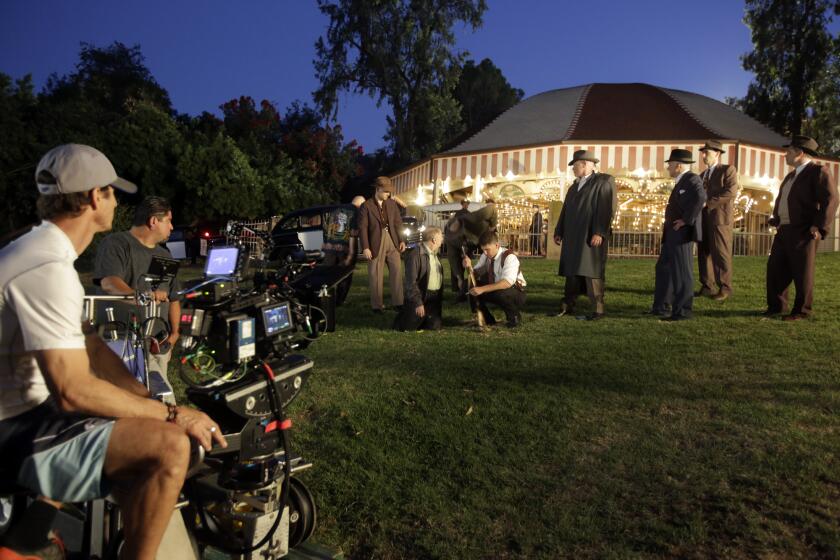Hollywood’s all-important summer box office has never been less predictable

- Share via
Summer movie season is here, which means another season chock full of sequels, “re-imagined” classics and, yes, a smattering of risky originals.
If you already believe that Hollywood is out of ideas, you won’t find much contradictory evidence at the local multiplex in the coming months. As much as audiences say they crave originality, how they actually spend their money tells a different tale, with 2024’s full-year top 10 completely dominated by existing intellectual property.
So studios are sticking with what has worked before.
Will it work again?
Some studio executives anticipate that the summer box office — which runs from the first weekend in May through Labor Day — will generate close to $3.75 billion in domestic ticket sales. That would be up slightly from last year, but still down significantly from pre-pandemic levels. Others anticipate a total of $3.5 billion, which would mark a decline from a year ago.
Executives say that the lineup is strong on paper, though uncertainty abounds and August is lacking in compelling titles.
Despite the challenges, the summer months remain an important gut check for the film industry, producing around 40% of the annual totals in the U.S. and Canada. The last time summer movies tallied $4 billion in revenue — once a typical haul — was two years ago, the year of “Barbenheimer,” and that was a unique post-COVID 19 pandemic phenomenon.
Kevin Goetz, founder and chief executive of entertainment data and research firm Screen Engine/ASI, predicts a “solid” summer, though he doesn’t expect the industry to get back to 2019 levels.
“I don’t think we ever get to that place again where we say, ‘Oh, we’re back,’” Goetz said. “We’re certainly in full-on recovery mode. But in the course of this last five years, audiences have shifted and changed.”
That said, there’s still room for surprises.
Box-office performance has become increasingly difficult to predict for the studio “tent pole” releases, film executives say. Distribution chiefs do their best to forecast opening weekend results based on data from audience-tracking firms, which help studios see whether their marketing efforts are working and gives them a chance to change course.
But those models aren’t picking up what’s causing certain movies to overperform these days — the late-breaking viral buzz and last-minute marketing decisions that drive young people to the theaters with a fear of missing out, or FOMO. That’s what happened with Warner Bros.’ “A Minecraft Movie,” one of the year’s biggest surprise hits.
Goetz said that’s a function of the nature of audience tracking. It’s not broken, he argues. It’s misunderstood.
“Tracking was invented not a parlor game but as a way to measure the efficacy of your advertising flight,” Goetz said. “It is not meant to predict a finite number.”
After a quiet Mother’s Day weekend, theaters are hoping a series of highly anticipated movies gets the momentum back on track. Thanks to the performance of “Minecraft” and Ryan Coogler’s breakout hit “Sinners,” box office so far this year is up 16%, according to Comscore.
Warner Bros.’ next effort, the horror reboot “Final Destination Bloodlines” is shaping up to do impressive business this weekend 14 years after the last one. Rival studio execs say it could open with $40 million in sales. The studio also has its DC Studios strategy on the line this year with the release of James Gunn’s “Superman,” a character that has sometimes proved difficult to make compelling on the big screen.
Walt Disney Co. has a big franchise-filled summer ahead, with some major gambles on the schedule.
The Burbank giant officially kicked off the season with “Thunderbolts*,” a middling performer for Marvel Studios commercially, though the studio can take heart that reviews were strong and audiences enjoyed it. The improvement in quality contributed to a solid second weekend for “Thunderbolts*,” which declined 55% to top the domestic charts with $33.1 million, a pretty good hold for a superhero movie these days.
The upcoming live-action “Lilo & Stitch” is expected to win a busy Memorial Day weekend, likely easily beating Paramount’s expensive “Mission: Impossible — The Final Reckoning,” which debuts at the same time. The original “Lilo” is one of Disney’s few non-Pixar animated films of the 2000s with a lasting cultural footprint (I’m not counting the cult of “The Emperor’s New Groove,” though I see you, fellow millennials).
It’s way too soon to know what Pixar’s “Elio” will do at theaters. The last time Pixar put out an original movie was 2023’s “Elemental,” which opened to weak numbers but recovered enough to eventually collect $496 million worldwide.
“The Fantastic Four: First Steps” is Marvel’s mega-swing of the year. Kevin Feige is attempting to succeed at a task no one has yet accomplished: making a good “Fantastic Four” movie.
Universal Pictures will have one of the biggest releases of the year with “Jurassic World Rebirth,” yet another installment in its killer dino franchise. Hopes are high for “How to Train Your Dragon,” the company’s attempt to follow Disney with a faithful live-action version of the popular Dreamworks Animation property (which has its own themed land at Universal’s soon-to-open Epic Universe park in Orlando).
Besides “Mission: Impossible,” Paramount has two revivals on offer: “Smurfs” and “The Naked Gun,” a rare pure comedy from a major studio, which could be an advantage. Sony is counting on “Karate Kid: Legends,” as well as returning horror titles “28 Years Later” and “I Know What You Did Last Summer,” to fuel its finances.
As for spinoffs, Lionsgate has “Ballerina,” a “John Wick” offshoot featuring Ana de Armas’ character.
Apple’s film unit is bucking the I.P. trend with the big-budget “F1,” a racing drama starring Brad Pitt, which will be a serious test of the iPhone maker’s big-screen ambitions. It’s a wild card that analysts are hoping plays more like a burnt-rubber version of “Top Gun: Maverick” (from the same director, Joseph Kosinski) and less like Apple’s other cinematic outings.
With originals like “Elio” and “F1” especially, quality is key, as is the strength of the brands behind them: Pixar and Formula 1 racing. “Even though those movies present more of an original idea, they still have marketable elements that are compelling to lean into,” Goetz said.
You’re reading the Wide Shot
Ryan Faughnder delivers the latest news, analysis and insights on everything from streaming wars to production — and what it all means for the future.
You may occasionally receive promotional content from the Los Angeles Times.
Stuff we wrote
Number of the week

President Trump’s movie tariffs idea threw Hollywood into chaos, but there are some in the industry who are trying to make the most of the moment.
This week, Trump’s Hollywood “ambassadors” Jon Voight and Sylvester Stallone joined the film and TV business unions and trade groups to call for tax provisions that they say will help make it more affordable to shoot in the U.S., The Times’ Samantha Masunaga reported.
In a letter to the White House, which was obtained by The Times, the groups said they support Trump’s proposal to create a new 15% corporate tax rate for domestic manufacturing activities that would use a provision from the old Section 199 of the federal tax code as a model.
The letter also asks Trump to extend Section 181 of the federal tax code and increase the caps on tax-deductible qualified film and TV production expenditures, as well as reinstating the ability to carry back losses, which the groups say would give production companies more financial stability.
These are modest ideas compared with Trump’s proposal for 100% tariffs on foreign-made movies and Gov. Gavin Newsom’s demand for a $7.5-billion federal incentive.
As a reminder though, California’s problem isn’t just that productions have moved to Canada, Britain and Hungary. Other states are taking business as well.
Late last week, New York Gov. Kathy Hochul signed the state’s budget, which increased the cap for its film tax credit to $800 million a year, up from $700 million. That would top Newsom’s proposed increase, which would raise California’s incentive program to $750 million.
Finally ...
Listen: New music from Swedish goths Ghost.
Read: The best of the Chicago pope memes.
Inside the business of entertainment
The Wide Shot brings you news, analysis and insights on everything from streaming wars to production — and what it all means for the future.
You may occasionally receive promotional content from the Los Angeles Times.












